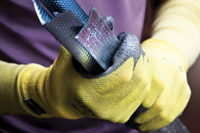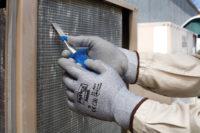According to the National Safety Council’s 2011 “Injury Facts”, the manufacturing and construction industries accounted for 37,080 injuries to fingers and 13,940 to hands. Many workers are exposed to significant risks ranging from cut and puncture wounds to high abrasion, impact, broken bones and vibration injuries.
What does this mean for the employer?
It means expensive downtime and medical costs.
It has been estimated that these types of injuries amount to hundreds of millions of dollars per year in lost production time, medical expenses and workers’ compensation. According to the NSC, cuts/scrapes and puncture injuries cost $11,454 and more severe lacerations, impact and puncture injuries cost $16,432 for medical and indemnity costs. Second to back injuries, the most recent report from the Bureau of Labor Statistics states 25.3 percent of all work-related injuries resulting in days away from work were hand-related. The actual numbers are likely to be higher as many injuries are unreported.
Gloves make a difference
For many, the use of hand protection isn’t mandatory and, in many instances, it is overlooked. Truth is, reducing the impact your hands take when performing certain tasks can protect joints from excessive wear as well as prevent blistering, cuts, heavy impact or, in some cases, physical disfiguration. Losing a finger in an accident can have ramifications on how individuals go through their day-to-day routine.
It’s safe to say that wearing the proper hand protection can drastically reduce hand injuries in the workplace, but worker safety is more than just putting on a pair of gloves. Statistics from the National Safety Council show that 70 percent of workers who experienced a hand injury on the job were not wearing gloves. The remaining 30 percent of injuries were due to inadequate, damaged or improper use for the type of hazard present. No longer does the saying “if the shoe fits, wear it” apply. High performance glove manufacturers are making big strides in improving fit, feel and functionality all while protecting the worker and improving their performance on the job.
Latest OSHA statistics
Here are a few statistics to consider about hand injuries on industrial and commercial jobs:
- The cost per injured worker averages $16,000, which includes medical costs, lost time (approximately five days), downtime and cleanup.
- Fractures continued to require the highest median days away from work (30 days) in all private industries, followed by carpal tunnel syndrome (28 days). within goods-producing industries, fractures had the highest median days away from work as well (35 days), followed by carpal tunnel syndrome (28 days). Service-providing industries reversed this pattern, with carpal tunnel syndrome having the highest median days away from work (28 days) followed by fractures (27 days).
- Injuries from repetitive motion continue to be the event with the highest median days away from work for all private industries (20 days) and service-providing industries (19 days).
- Common causes for hand injuries are poor ergonomics, manual handling of heavy loads, equipment issues, inadequate safety training and protective clothing.
Glove technology
The days of the “one size fits all” work glove are over. High performance glove manufacturers give an enormous amount of attention to the size and shape of the hand. Anatomical correctness insures a snug fit for better control and maneuverability. Further, the incorporation of tapered stretch side panels has greatly improved the glove’s fit between the fingers for comfort that lasts all day. If the worker has to remove the gloves for relief, their safety is compromised.
Fit, feel and functionality are critical features for glove manufacturers. Manufacturers are working with a variety of fabrics to improve performance as different materials are proven to perform more effectively for specific tasks. Clarino® synthetic leather, for instance, is used because of its versatility. It can be made to simulate suede and top-grain leather, and being a man-made material, it’s washable and supple when wet, unlike natural leather. Of course, there are many types of materials being incorporated in high performance work gloves. Thermal plastic rubber can be sonic welded to the glove providing impact protection to injury-prone areas of the hand such as the fingers, knuckles, wrist and dorsal.
Form-fitting Spandex is widely used to insure a snug fit and is often used as a base layer in which additional materials are added to improve wear and protection. Various types of leathers offer comfort, extreme durability, and heat protection including: cow, pig, and kangaroo. Building a glove from the base is truly a work of art as much as it is an engineering feat. New technology creates a hurdle with cost, and it’s important to recognize the features that work best for the type of application.
Task-specific hand protection
Maximizing individual safety and productivity has lead to specialty hand protection utilizing unique features designed to protect workers performing specific tasks. Furthermore, task-specific hand protection is becoming a mandatory piece of personal protective equipment (PPE), which has to meet specific standards for specific industries. It is the responsibility of the supplier to correctly classify their products and not overstate product features and performance ratings. This allows the employer to carefully select the proper PPE for their employees.
Workers seeking cut protection demand a glove that is designed to handle a specific cut rating depending on the type of machinery that is operated and the type of materials being handled. Not only do they need a specific cut level, they also require tactile qualities, breathability and abrasion protection.
Construction workers deal with highly abrasive materials that cause serious damage to unprotected hands. Gloves designed for this type of work demand impact protection on the top of the hand, palm padding to reduce blisters and hand fatigue, textured grip for handling tools, and a snug fit for optimum comfort and dexterity.
Depending on the environment, specific luminance levels may also be required for improved visibility and safe operation.
Task-specific hand protection is all about the added benefits that maximize individual safety and productivity. Safety is an inexpensive and effective insurance policy and as the saying goes, “Know safety, no injury. No safety, know injury.”



